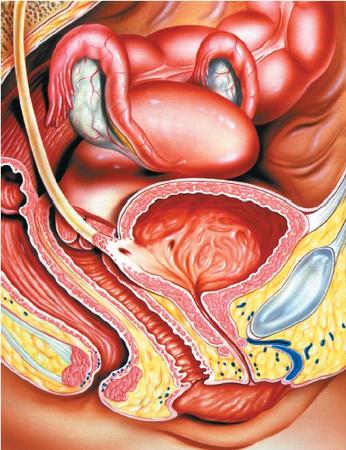Reproductive system
The reproductive system is a group of organized structures that make possible the creation, or reproduction, of new life for continuation of a species. Human reproduction is sexual, meaning that both a male and a female contribute genetic material in the creation of a new individual. During puberty, usually occurring between the ages of nine and fourteen, the reproductive systems of both sexes mature. The ovaries of a female release eggs (female sex cells) and a male's testes produce sperm (male sex cells). Reproduction occurs when a sperm unites with an egg, a process called fertilization.
The male reproductive system
The main tasks of the male reproductive system are to produce sperm cells and to introduce sperm into the female reproductive tract. Sperm are produced in the testes, the pair of male reproductive glands located in the scrotum, a skin-covered sac that hangs from the groin. Within each testis are hollow tubules called seminiferous tubules where sperm cells are produced. The testes also secrete the male hormone testosterone, which stimulates development of the reproductive structures and secondary sexual characteristics (such as deepened voice) at puberty.
After production, sperm cells move to a highly coiled tube called the epididymis, where they mature and are stored. During ejaculation (the ejection of sperm from the penis during orgasm), sperm travel from the epididymis through a long tube called the vas deferens to the urethra. The urethra is a single tube that extends from the bladder to the tip of the penis (and through which urine passes out of the body). Secretions from three different glands mix with sperm before it is ejaculated, forming the seminal fluid, or semen. Ejaculated semen may contain as many as 400 million sperm.
The penis is the male reproductive organ that delivers semen into the female reproductive tract. It consists of a shaft, the glans (or head region), and a foreskin. It is common practice in certain cultures and religions to have the foreskin removed, or circumcised. During sexual arousal, blood vessels in the tissue of the penis fill with blood, causing it to swell and reach a state of erection. The penis becomes longer, wider, and firm, allowing entry into the female vagina.
Words to Know
Fertilization: The union of an egg and a sperm that initiates the development of a new individual with genetic material from both parents.
Follicle: A sac in the ovary that contains a developing egg surrounded by a group of cells.
Gene: A section of a chromosome that carries instructions for the formation, functioning, and transmission of specific traits from one generation to another.
Hormone: A chemical produced in living cells that is carried by the blood to organs and tissues in distant parts of the body, where it regulates cellular activity.
Menstruation: The monthly shedding of the uterine lining and blood in a nonpregnant female.
Ovary: One of the paired female sex organs that produces eggs and sex hormones.
Ovulation: The release of a mature egg from an ovary.
Ovum: A female sex cell.
Puberty: The period of development of the sexual structures and secondary sexual characteristics in humans and higher primates.
Semen: Fluid containing sperm, nutrients, and mucus that is ejaculated from the penis during orgasm.
Sperm: A male sex cell.
Testis: One of a pair of male sex glands that produces sperm and sex hormones.
The female reproductive system
The main tasks of the female reproductive system are to produce ova, receive sperm from the penis, house and provide nutrients to the

developing embryo (fetus), give birth, and produce milk to feed offspring. Ova are produced in the ovaries, oval-shaped organs in the groin that also produce sex hormones. At birth, a female's ovaries contain hundreds of thousands of undeveloped eggs, each surrounded by a group of cells to form a follicle (sac). However, only about 360 to 480 follicles reach full maturity.
During puberty, the action of hormones cause several follicles to develop each month. Normally, just one follicle fully matures, rupturing and releasing an ovum through the ovary wall in a process called ovulation. The mature egg enters one of the paired fallopian tubes, where it may be fertilized by a sperm and move on to the uterus to develop into a fetus. The lining of the uterus, called the endometrium, prepares for pregnancy each month by becoming thicker. The lining is shed during menstruation if fertilization does not occur.
The uterus, or womb, is the organ in which a fetus develops and receives nutrients and oxygen. At its base lies the cervix, which widens during birth to allow passage of the fetus. The vagina is a muscular tube extending from the uterus to the outside of the body. It is the receptacle for sperm that is ejaculated during sexual intercourse and also forms part of the birth canal. The external genital organs, or vulva, include the labia, clitoris, and mons pubis. The labia are folds of skin on both sides of the openings to the vagina and urethra. The clitoris, a small, sensitive organ located in front of the labia, is comparable to the male penis. The mons pubis is a pad of fatty tissue above the clitoris.
During pregnancy, the female hormones estrogen and progesterone stimulate enlargement of the breasts and mammary glands. About two days after birth, blood levels of these hormones drop, and the pituitary gland releases the hormone prolactin, which stimulates the production of milk. Milk flows through small openings in the nipple of each breast to the nursing infant.
[ See also Birth ; Contraception ; Hormone ; Reproduction ; Sexually transmitted diseases ]